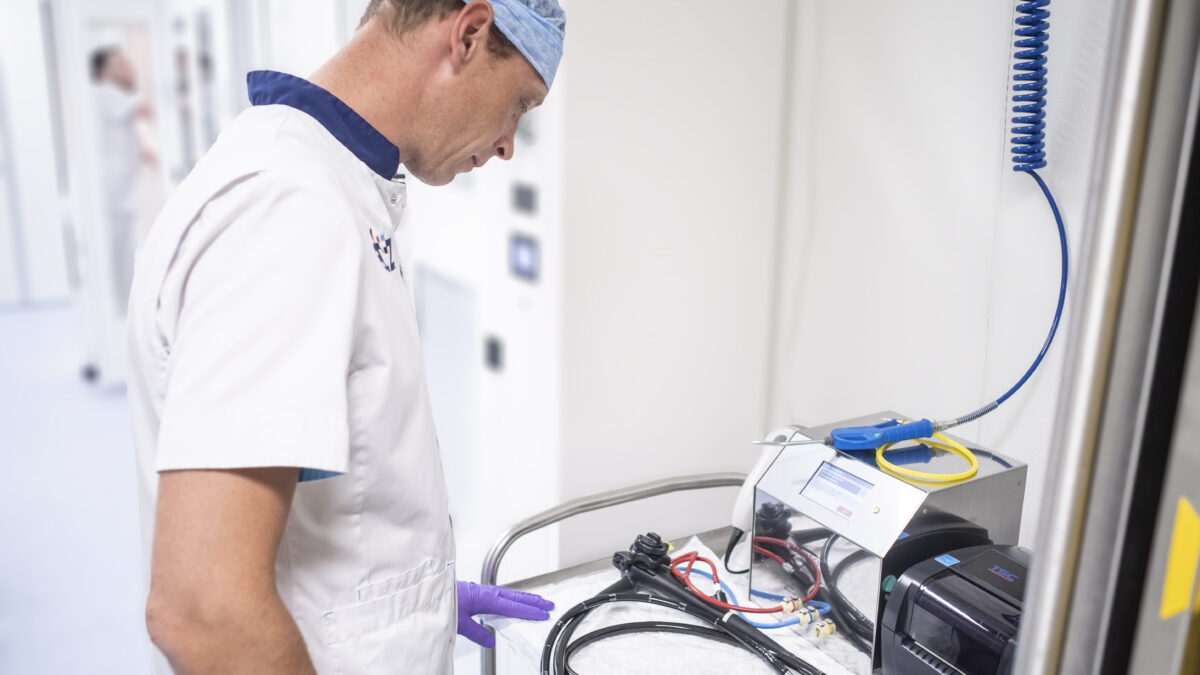A Holistic View on Patient Safety in Endoscopy
Patient safety in endoscopy must be approached from a holistic perspective, through solutions which increase detection rates of abnormalities, increase confidence in the safety of the reprocessing outcome, and control the risk of infection and cross-contamination. With these important benefits in mind, PENTAX Medical is continuously working to innovate products to establish solutions that directly tackle patient safety in endoscopy – like the DISCOVERYTM, the PlasmaTYPHOON and PlasmaBAG system, and the DECTM Video Duodenoscope ED34-i10T2 with disposable elements.
INCREASED DETECTION RATES OF LESIONS WITH ARTIFICIAL INTELLIGENCE
In the fight against colorectal cancer, great strides have been taken to protect patients from undetected abnormalities. However, up to 26% of lesions are still missed in examinations.1 Endoscopists’ tiredness or distraction can play a role in complicating the detection. This can lead to fewer lesions detected, with studies showing early-morning cases yielding 27% more polyps per patient, than cases later in the day.2 The human factor is responsible for complications leading to missed lesions, thus having negative impact on the medical outcomes of examinations, ultimately compromising patient safety.
By incorporating artificial intelligence (AI) technology in colonoscopies the procedures become more objective and operator independent. No matter how subtle or unremarkable the lesion, the DISCOVERY™ is always a focused observer.
The database of the DISCOVERY™ is what truly sets it apart from any other solution in the market. During a procedure, the DISCOVERY™ highlights suspicious areas according to insights learned from the database.
This database contains thousands of dedicated images of each kind of polyp, annotated by five renowned CRC centers worldwide. By learning from this database, the DISCOVERY™ is able to raise the attention to lesions otherwise difficult to detect. With patient safety as the greatest priority, this solution could have a positive impact on the 26% of lesions still missed in examinations.1 Peter Siersema, Professor of Endoscopic Gastrointestinal Oncology at the Radboud University Medical Center Nijmegen explains, “Computer-aided detection has been shown to increase the detection of pre-cancerous colorectal lesions. The introduction of the DISCOVERY™ artificial intelligence system opens the door to a new era where endoscopists and DISCOVERY™ jointly reduce healthcare costs by decreasing the prevalence of colorectal cancer.” The DISCOVERY™ not only presents the opportunity to improve the patient’s lives, it can also be implemented in hospitals cost-effectively.
IMPROVED CONFIDENCE IN REPROCESSING OUTCOMES THROUGH OPTIMIZED DRYING
As patient safety requires a holistic approach, other concerns such as improper reprocessing must be addressed. Meticulous cleaning and high-level disinfection is needed to guarantee a clean and safe use on subsequent patients. When flexible endoscopes are not dried properly after reprocessing, microorganisms can proliferate due to residual moisture and represent a source of infection for subsequent examined patients.3,4
As effective drying and storage procedures are crucial to prevent post-endoscopic infection, this is an important aspect of patient safety.4 The Plasma TYPHOON is the first solution to guarantee a dry endoscope in one to five minutes (the drying time depends on the endoscope type), and storage up to 31 days in a fully controlled environment (storage times are subject to local regulations).5 After the completion of the drying process, the single use PlasmaBAG comes into play: Plasma, containing ozone molecules, is insufflated into the bag ensuring the dry and disinfected state of the endoscope is maintained due to biocidal effect of the ozone.
MINIMIZED RISK OF CONTAMINATION WITH DISPOSABLE ELEMENTS
Innovative solutions for proper cleaning of endoscope channels are critical to minimizing the risk of contamination, and safeguarding patient safety. Concerns of cross-contamination arose after increasing incidences of Carbapenem-resistant Enterobacteriaceae (CRE) and other infections. These infections may be linked to improper cleaning and/or disinfection of the duodenoscope’s elevator mechanism. Prof. Marco Bruno, Director of Endoscopy in the Department of Gastroenterology and Hepatology at the Erasmus Medical Center in Rotterdam explains, “a solution to the risk of infection, is to modify current endoscopes so that they have disposable parts. Especially the parts that are most susceptible to contamination. Another solution would be to have fully disposable endoscopes. This of course introduces questions about pricing and the environmental impact, which need to be solved by manufacturers and medical facilities before this solution can be used in daily practice.”
PENTAX Medical has developed an innovative product which aims to address one of the main areas of concern in terms of potential infection … the elevator. The DEC™ Video Duodenoscope ED34-i10T2 seeks to respond to the need for enhanced patient safety in endoscopy; it is a unique and innovative advancement in cleaning capabilities for infection prevention and control, with the single-patient use, sterile, disposable elevator cap (DEC™). The DEC™ allows simplified reprocessing and increased cleaning capability, thus helping to reduce the risk for cross-contamination. With this solution there is greater reprocessing efficiency, 35% reduction in distal end reprocessing steps due to better access for cleaning and disinfection, as well as disposability of the elevator (In comparison to the standard duodenoscopes of the major manufacturers. Source: PENTAX Medical internal benchmarking). In line with Prof. Marco Bruno’s recommendation to introduce disposable elements, as part of their hygiene commitment, PENTAX Medical has also introduced single use valves and single use cleaning brushes, allowing for simplified reprocessing and increased cleaning capability. Additionally, PENTAX Medical will soon offer the DEC™ in a hygiene procedure pack combined with core consumables in order to further minimize the risk of infection in complex endoscope areas.
With patient safety as the greatest priority, manufactures should offer innovative solutions that protect patients and provide clear benefits to clinicians.
REFERENCES
1. van Keulen KE, Soons E, Siersema PD. The Role of Behind Folds Visualizing Techniques and Technologies in Improving Adenoma Detection Rate. Curr Treat Options Gastroenterol 2019;17(3):394-407.
2. Wilcox M. Exam 1: Timing of Myelosuppression During Thiopurine Therapy for Inflammatory Bowel Disease: Implications for Monitoring Recommendations. Clinical Gastroenterology and Hepatology
2009;7(11):1141-1142.
3. Robert Koch Institute (RKI). Recommendation of the commission for hospital hygiene and prevention of the RKI. Hygiene requirements for reprocessing flexible endoscopes and additional endoscopic
instrumentation. Bundesgesundheitsbl Gesundheitsforsch Gesundheitsschutz 2002;45:395 – 411.
4. Kovaleva J. Endoscope drying and its pitfalls. J Hosp Infect 2017;97(4):319-328.
5. Evaluation of the ability of a storage system (plasmabiotics) to maintain the microbiological quality of heat sen
Source : TheSynapse Magazine Issue No.3, 2021




